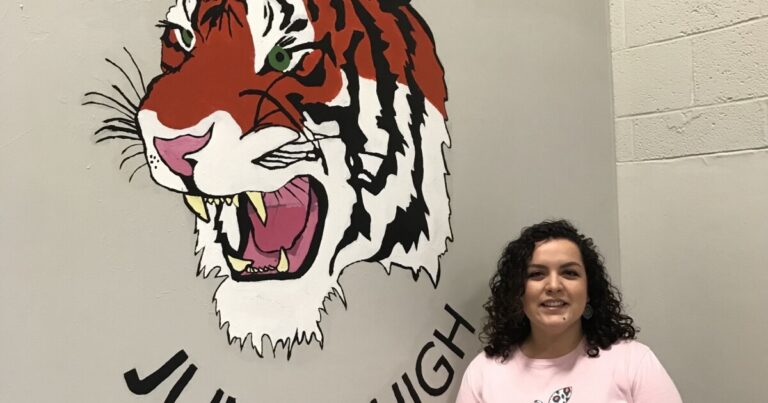My name is Karen Quiñonez-Hernandez. I teach seventh grade math in the Carthage School District in Carthage. It’s a town of about 15,500 people in Jasper County in southwest Missouri.
I would like to start by painting a picture of the school district that I work in. This town is very special and unique compared to surrounding communities. Southwest Missouri is a rural area with a predominantly white population. However, the Carthage School District is about 42% Hispanic and 53% white. In addition, English Language Learners make up 24% of the student population, and about 60% of students receive free or reduced lunches. I have always imagined myself teaching at a school district like this. Since I am bilingual in English and in Spanish, I feel like what I bring to the table is definitely valued here because the district is in need of Spanish speaking professionals.
As I mentioned before, I teach seventh grade math all day long. That might sound a little boring to most, but I teach in English part of the day, and some of my lessons are completely in Spanish. This definitely helps break up the day for me. Currently, Carthage offers a kindergarten through eighth grade Dual Language program. We are the only rural district in Missouri to offer that program. Other urban districts such as Kansas City and St. Louis also offer this immersion program. We hope to expand this program through the 12th grade.

Karen Quinonez Hernandez
/
My Dual Language students are a mixture of children whose first language is English and students whose first language is Spanish. They have all been taking Dual Language classes together since they were in kindergarten. By the time they get to me, they are all fluent in both languages. These students are working so hard to become proficient in both English and Spanish. They are meeting grade level expectations in core areas in both program languages! These students have been capable of demonstrating cultural competence by understanding different cultures and being open to different cultural perspectives.
Working in a district with a unique program like this comes with a few challenges and rewards for both teachers and students. I have noticed that there is a lack of bilingual resources available for teachers to use or purchase. It’s up to the classroom teacher to come up with all new activities that are in Spanish or translate an activity that was originally created in English. Therefore, anything I create in English, I must also translate to Spanish for my Dual Language classes. As the program progresses into high school next year, it becomes more and more difficult to find educators who are bilingual or certified in Spanish that are also certified to teach in another content area. Unfortunately, the national teacher shortage will prove to make this even more challenging.

Karen Quinonez Hernandez
/
Any teacher who teaches in a Dual Language program will most likely agree that it is double the work, however, it is so worth it. The parents that enrolled their kids in this program have been so incredibly supportive and want to see their children succeed. Like I said earlier, these kids have been together since kindergarten. As you can probably imagine, the energy they bring to the classroom on the first day of school is at another level. They act like siblings, they support each other, lift each other up, and even argue like siblings sometimes. These students are leaders. I know the program is doing something right when I see them at school events translating for community members who only speak Spanish. I love seeing the look on people’s faces when they hear a student speaking in Spanish and they weren’t expecting it. My students are determined and all of their perseverance is paying off. I remember earlier this year when a former student of mine was telling me all about her Algebra class. She mentioned that it takes her a little while to understand what is going on because she is receiving her lesson in English but she is processing in Spanish. I was so ecstatic to hear that from her! Keep in mind, this student’s first language is English and that is all she speaks at home to her family, but, because she has been used to thinking critically in Spanish at school, she has continued to do that even in her English speaking classes.
I am so incredibly grateful to have the opportunity to teach the content that I love in the language that I grew up speaking. I never knew that being able to explain mathematical concepts to middle school students in two different languages would be so rewarding. Seeing that “aha” moment whenever the concept isn’t making sense in English, and I try explaining it in Spanish and it clicks is such a good feeling. The whole point is for them to understand math. Mathematics is its own language and I am so incredibly proud of my students to be learning it and understanding it in a foreign language.



